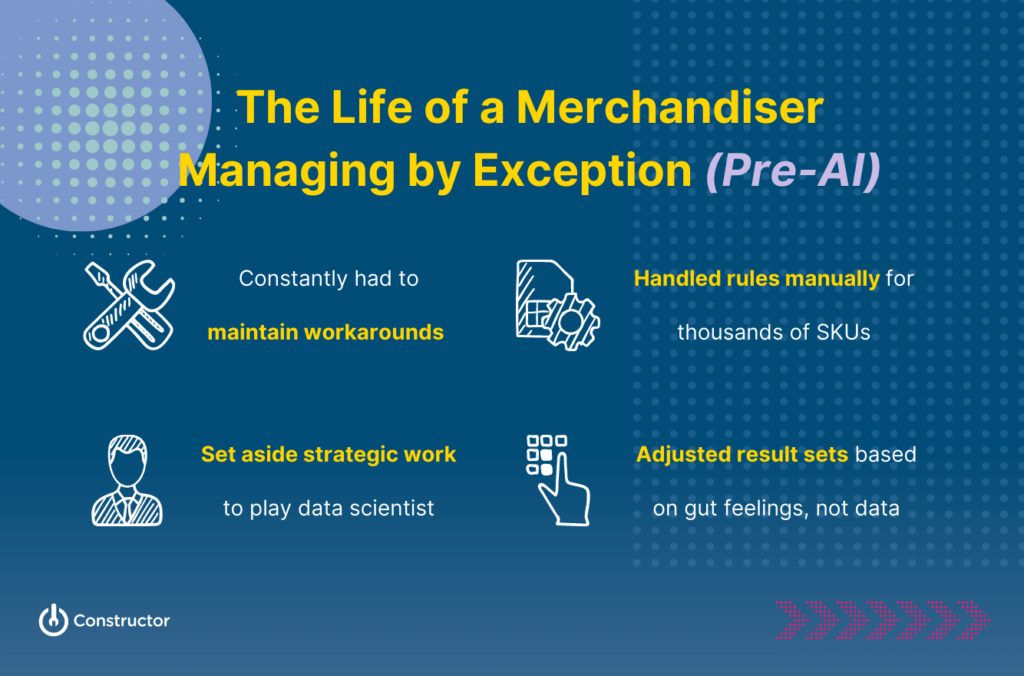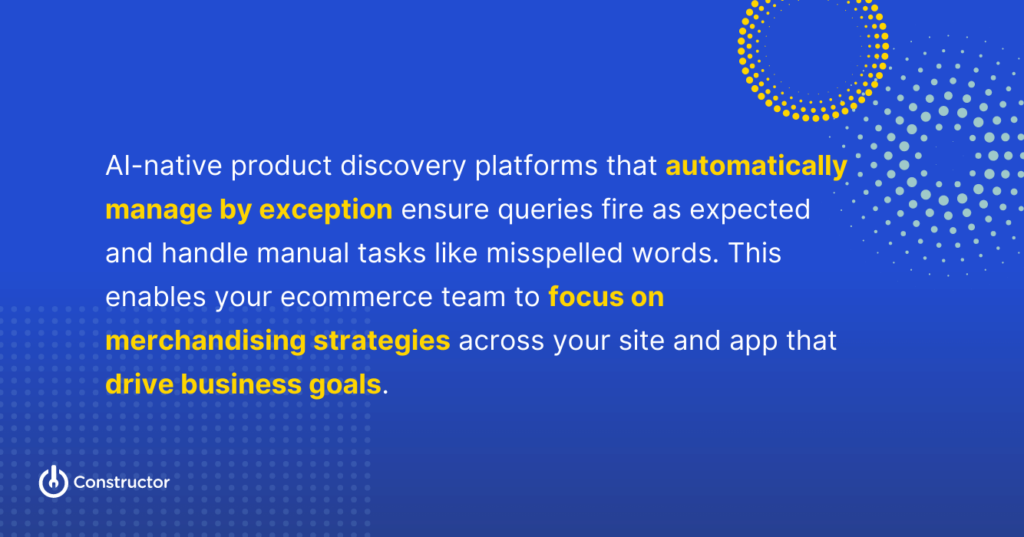Not all heroes wear capes –– though some may help sell them, spending their days and nights answering the bat signal of business distress.
The real heroes of ecommerce? Merchandising teams. Their multifaceted roles include constantly managing extensive workloads, creating personalized customer experiences, and seeking ways to streamline business operations.
By leveraging a strategy known as managing by exception, they can efficiently allocate resources and address specific issues that deviate from norms or benchmarks. This can get them closer to focusing on critical areas that require immediate attention while maintaining a broader perspective on overall business outcomes.
Let’s take a look at how managing by exception has evolved to make the lives of merchandisers easier, thanks to product discovery solutions powered by artificial intelligence (AI) and machine learning (ML).
What Is Managing by Exception?
Just as a sailor focuses his course, making adjustments only when faced with rough waters or unexpected obstacles, ecommerce merchandising teams expertly navigate anomalies as well. Their approach to stormy seas? Managing by exception, or strategic decision making to tweak how their product discovery solution functions.
This strategy focuses attention and resources primarily on addressing situations that deviate from the expected or standard operating conditions. Instead of closely monitoring every aspect of a process or operation — which, as most merchandisers know, is a quick path to burn out — systems are put in place to automatically track key performance indicators (KPIs) or critical thresholds. When these indicators fall outside predefined norms, intervention is required.
The main idea behind managing by exception is prioritization of efforts and resources where they are most needed, rather than spreading them thin across all areas. This allows for streamlined decision making and problem solving by concentrating on the instances that have the most significant impact or potential risk.
Like most other aspects of running an online business, managing by exception has now entered a new era of advancement, thanks to the integration of AI. Let’s take a look at how managing by exception has evolved over the years.
How Merchandisers Traditionally Managed by Exception

Before the rise of AI-powered solutions, searchandising with traditional keyword search engines required a much heavier lift. It also brought with it many limitations, inefficiencies, and frustrations.
Handling rules and data analysis for hundreds or thousands of SKUs in digital catalogs consumed weeks (sometimes months) of merchandisers’ time. And misfiring result sets forced merchandising teams to set aside needle-moving strategic work and play data scientist to manually adjust logarithmic functions.
Over time, these manual workarounds led to time-consuming maintenance and became a major burden for ecommerce teams. Plus, they can’t happen at scale nor guarantee successful business outcomes as placing products for any given query was based on gut feelings, not data.
This is why teams often turned to metrics like relevance, which isn’t always the best indicator of a product’s success or a guarantee to achieve business goals.
The Ultimate Guide to Searchandising with Constructor
In this comprehensive guide, learn exactly how our Search and Browse Capabilities, Merchant Intelligence, and Native Commerce Core empower merchandisers and product managers to consistently create personalized shopping experiences that don't just convert, but drive business KPIs.
How Managing by Exception Evolved, Thanks to AI-Powered Solutions
When AI and ML stormed into the product discovery landscape, tools natively powered by them reduced the manual, tedious tasks on so many merchandisers’ plates, making room for objectives that have a more direct and strategic impact on business goals.
Their transformers, large language models (LLMs), and advanced algorithms collect and leverage big data like clickstream to better understand user intent and personalize customer experiences in real-time across your site.
The internal search engine also automatically ranks products according to business KPIs your team cares about — no educated guesswork involved. (This leads to double digit lifts in conversions.)
All this combined equates to merchandising teams gaining hours of time back when integrating AI- and ML-powered solutions.
Instead of being bogged down with jobs like deciphering whether search queries fire as expected or managing manual tasks like misspelled words, the AI automatically does it for them. This means ecommerce teams can focus on various merchandising strategies across their sites and apps, occasionally sending over additional insights to the AI as needed.
In other words, they manage by exception to drive business goals.

Streamline Merchandising to Achieve Even More with Less
Along with automating manual tasks, the right tools should also be intuitive and easy for merchandising teams to use. For example, a clear and user-friendly dashboard that provides glanceable insights for search performance allows merchandisers to quickly correct anything out of place to better serve business goals.
These tools should also integrate seamlessly into existing systems. As AI continues to evolve, it’s more important than ever to stay agile and open to adapting new technologies that can further enhance merchandising efforts.
Get a detailed inside look at how Constructor provides exactly the capabilities you need to boost KPIs across your entire site — but still lets the heroes call the shots — in our guide to AI-assisted merchant tools.
The Ultimate Guide to Searchandising with Constructor
Learn how ecommerce AI – not just any AI – improves KPIs and team efficiency.

